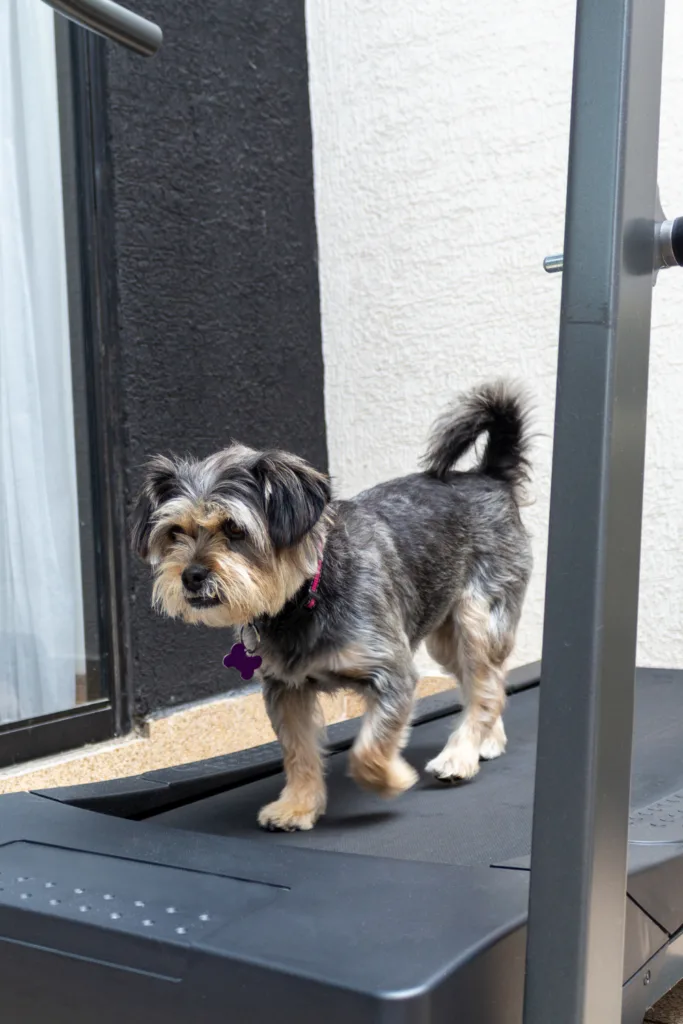Believe it or not, dog treadmills are now a thing as pet owners look for more ways to exercise with their furry friends.
If you’re thinking of purchasing a dog treadmill, then this guide will provide you with everything you need to know.
The good news is there are different types of dog treadmills on the market nowadays.
From manual and motorised treadmills to underwater treadmills, there are a range to cater for you and your pooch’s needs.
So what exactly should a dog treadmill be used for and how do you choose the best treadmill for your dog?
In this guide we’ll look at:
- What is a dog treadmill?
- What are the benefits of using a dog treadmill?
- How to choose the right dog treadmill
- How to train your dog to use a dog treadmill
- How to use a dog treadmill safely
- How to maintain and clean a dog treadmill
- Dog treadmill Q&A
Ready?
Let’s go!

What is a dog treadmill?
A dog treadmill is a tool used in a variety of ways to provide physical benefits.
The main use cases tend to be preparation for sports or events and rehabilitation.
Dog owners can use them to prepare their pooch for a show, whereas vets use them to conduct a gait analysis and perform rehabilitation after an injury.
There are different types of dog treadmills. The three main types are: manual, motorised and underwater.
Related: Running with a dog: The best and worst dog breeds to go running with
What are the benefits of using a dog treadmill?
There are many benefits of using a dog treadmill.
They provide many physical benefits such as weight loss, increased overall health and improved mobility.
The low impact nature of the treadmill means it is perfect for protecting joints and preventing injury.
Dog treadmills also have a range of mental health benefits for your pooch.
These include promoting less destructive behaviour, supporting healthy sleep patterns and reducing anxiety.
Benefits extend to dog owners too! If you cannot take your dog for a long walk, then a dog treadmill is a good option.
Likewise, if you live in a small space like an apartment, a dog treadmill is a good tool to have to allow your dog to get their required amount of daily exercise.
Related: The ultimate guide to running on a treadmill + 5 treadmill workouts

How to choose the right dog treadmill
The key when finding the right dog treadmill is to think about your dog’s needs.
The following factors should be taken into account when choosing a dog treadmill:
- Size of your dog
- Weight of your dog
- Breed of your dog
These will all determine the size and length of the treadmill required.
The treadmill should measure at least 2 times the length of your dog, but ideally 2.5 to 3 times their length.
For example, a larger breed of dog like a German Shepherd requires a treadmill with a higher weight limit, whereas a smaller breed like a Chihuahua may require a smaller, folding treadmill.
Next you’ll want to consider the type of treadmill. As we explained earlier, there are three main types:
- Manual. Great for dogs who require low impact exercise.
- Motorised. Great for dogs that require a more intense workout.
- Underwater. Great for dogs with joint problems as they provide a low impact, underwater workout.
Finally, consider the features of the treadmill on offer.
As with a treadmill that you would find in a gym, dog treadmills have features like automatic shut off, side panels and adjustable speed and incline options.
The bottom line? Put your dog’s needs first when choosing a treadmill.
It may require additional research, but finding the perfect treadmill for your furry friend will be worth it in the end.
Related: Indoor running: 4 of the best treadmill workouts for runners

How to train your dog to use a dog treadmill
Once you’ve found the perfect treadmill, follow this three-step process.
Remember training your dog to use a treadmill is a process that requires patience and positive reinforcement.
Always make sure your dog is comfortable and ready before moving onto the next step.
#1 Get your dog acquainted with the treadmill
The first thing you’ll need to do is make your dog comfortable with the treadmill.
Allow your dog to sniff around the treadmill, walk on it and get acquainted with it.
You will also want to teach your dog how to hop on and off the treadmill safely.
#2 Teach some basic commands
The next step will be to teach your dog some basic commands.
Practice with simple commands like “sit”, “stay” and “come” – these are important when it comes to interaction with the treadmill.
#3 Start with walking on a 0% incline
Turn the treadmill on at its lowest setting using a 0% incline and get your dog onto the tread deck. Encourage them to start walking forward.
You can use treats to lure your dog – it can take some time to build up their confidence and familiarity with the treadmill.
If your dog won’t hop onto the treadmill when the belt is moving, get them to hop onto the treadmill first whilst it’s stationery then turn on the treadmill at its lowest speed.
#4 Gradually increase the speed and intensity of the exercise
Next will be to gradually increase the speed and intensity of the exercise.
As you would do on an outdoor walk, it’s crucial that you slowly build up your dog’s tolerance over time instead of diving straight into high speed training.
Start with short sessions at a slower speed and work your way up from there.
Ideally, your dog needs to walk, trot, or run in the middle third of the treadmill deck.
It’s also important to adjust the speed of the treadmill to help them stay within the centre third of the tread deck during use.
Related: 12 trail running tips for beginners
How to use a dog treadmill safely
It’s important you supervise your dog on the treadmill at all times.
There is a risk that your dog could accidentally fall off and hurt themselves, so ensure you take the necessary precautions to keep them safe.
Many dog treadmills have the following safety features to prevent accidents so become familiar with these:
- A barrier that keeps your dog safely contained while they move.
- A safety stop button that will immediately shut off the treadmill in case of an emergency.
Monitor your dog as they walk or run on the treadmill to make sure they are using it correctly.
If your dog is walking or running with a limp or seems disoriented, then it may be a sign you need to adjust your dog’s workout routine or take them to a vet for a check-up.
Keeping your dog safe when using a treadmill is a priority, so with the appropriate supervision and monitoring, you’ll ensure your dog is getting a safe and effective workout.
Related: How to start run commuting: 8 ways to get the best out of your run to work

How to maintain and clean a dog treadmill
Regular maintenance of the treadmill is required to ensure you keep your dog safe.
Use the below checklist to maintain and clean your treadmill:
- Perform general maintenance: oil the belt and tighten the screws.
- Check for any damages.
- Clean the treadmill after each use with soap and warm water to prevent bacteria build up.
- Store the treadmill in a cool, dry place to prevent any damage caused by moisture or dust.
Related: Running 3 miles a day: Benefits + how to start
Dog treadmill Q&A
Q: Can a dog use a human treadmill?
A: No. It is not recommended to exercise your dog using a human treadmill unless they are a toy or small breed.
The length of a human treadmill is not long enough for most dog breeds, causing shortening of their gait.
Human treadmills also have a different suspension mechanism which has been designed for two legged as opposed to four legged users.
According to the Preventive Vet, dog treadmills are specifically are designed to provide the proper safety measures, support, and length for their intended user.
Related: Walking 5 miles a day: Benefits + tips to start
- 5 things I wish I’d known before returning to running - March 3, 2024
- Running 20 minutes a day: Benefits + how to start - January 27, 2024
- How to run your first 2 hour half marathon - January 16, 2024
